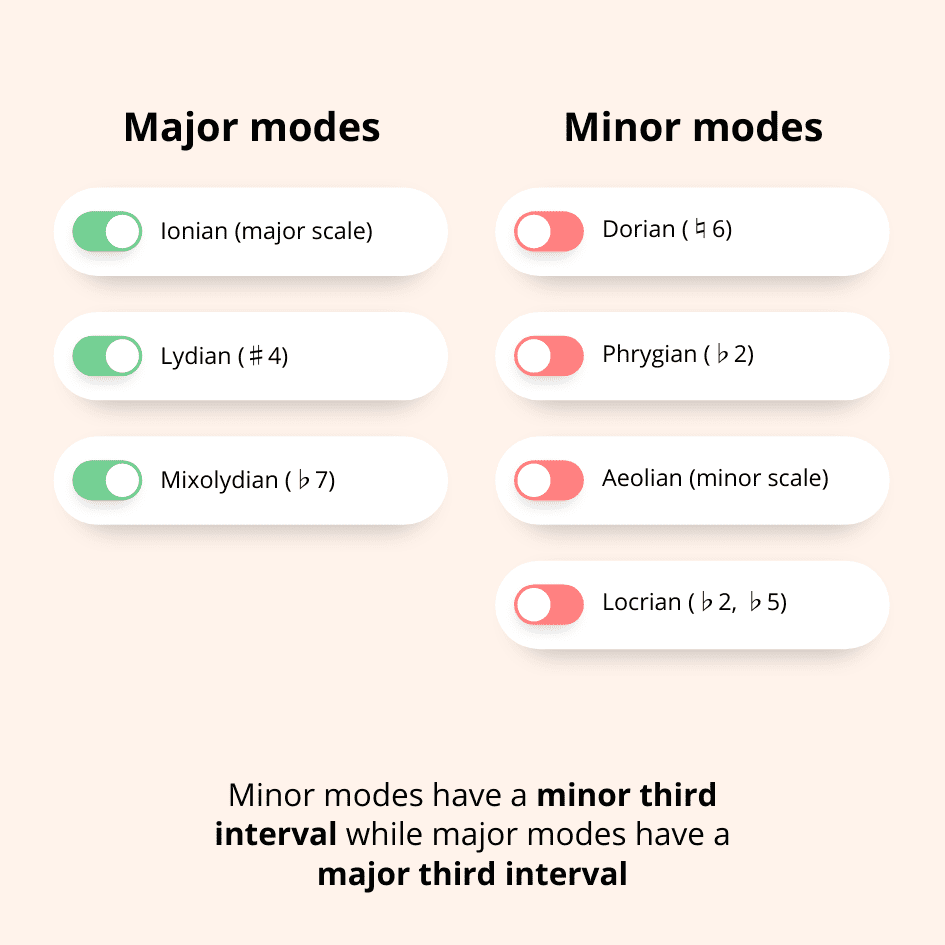
As we continue our trek through the seven diatonic modes of Western music, we finally arrive at one of my favorites: the Mixolydian mode.
The Mixolydian mode is essentially a major scale with a flattened (lowered) seventh degree.
This elimination of the “leading tone” into the tonic creates a sense of attitude, sass, or mischief, hence the title of this post.
To me, the Mixolydian mode really does feel like the major scale with just a touch of attitude.
Perhaps this is due to the fact that playing a 1 – 3 – 5 – 7 chord (normally a maj7 chord in a typical major key) is now transformed into a 1 – 3 – 5 – ♭7 chord (a dominant 7 chord).
Dominant 7 chords are very prominent in blues, jazz, and rock n’ roll, hence that sense of “roughness” that you don’t normally feel in a typical major scale.
In this post, we’ll talk about:
- How to build the Mixolydian mode
- Why the Mixolydian mode feels like an edgier version of the major scale
- Examples of the Mixolydian mode in popular music.
But first, let’s review why we study modes in the first place.
Table of Contents
What are musical modes and why are they important?
Musical modes are particular ways to organize musical pitches, not unlike a scale.
Modes are important because they can help us break out of the “major is happy” and “minor is sad” clichés, and allow us to express more nuanced emotions in our music.
In the Western classical tradition, there are seven primary modes, often referred to as diatonic modes:
Many folks will describe modes as just “major scales with different starting notes.” For example, if you take the C major scale…
C – D – E – F – G – A – B – C
…and shift the starting note (tonic) to the fifth degree (G), you would construct a scale in the G Mixolydian mode:
G – A – B – C – D – E – F – G
It’s all the same notes, just shifted over six degrees.
This is all well and good, but I don’t think it lends itself well to really learning and internalizing modes (or transposing modes into any other key besides C, because that’s always the one used in these examples).
A better way is to think of modes in two camps: major modes and minor modes.
Major modes are all the modes with a major third, namely:
- Ionian (classic major scale)
- Lydian
- Mixolydian
While minor modes are all the modes with a minor third:
You can think of each mode as a twist or variation of the standard major or minor scale.

What is the Mixolydian mode?
The Mixolydian mode, as we’ve just described, is a standard major scale with a lowered 7th degree.
Here’s the formula:
Whole Step, Whole Step, Half Step, Whole Step, Whole Step, Half Step, Whole Step
The great thing about this formula is that it works no matter what note you start on. Let’s take a look at the G Mixolydian scale you just heard in the previous section:
- First, we start off with G
- Then, we move a whole step to A
- Then, we move a whole step to B
- Then, a half step to C
- Then, a whole step to D
- Then, another whole step to E
- Then, a half step to F (this is where things differ from the major scale)
- Then, another whole step back to G

How the Mixolydian mode changes the major scale triads
While the Mixolydian mode only changes one scale degree, it has a massive effect on the overall vibe of your harmony.
Let’s look at how this one change alters the chords of a typical major scale.
To review, if we were to build triads on each of the degrees in the C major scale, we’d have these chords at our disposal:

However, because of our lowered seventh in the Mixolydian mode, a few of our chords are altered. Take a look (and listen):

Notice that the Mixolydian mode has altered three of our triads:
- The E minor turns into an E half-diminished
- The G major turns into a G minor
- And the B half-diminished turns into a Bb major
You’ll often hear that VII to I move a lot in Mixolydian tunes, specifically some of the ones we’ll look at in the following sections.
What does the Mixolydian mode feel like?
I think this hilarious YouTube comment pretty much sums it up:

The reason Daniel here is saying “minor in back” is because of that flattened seventh. The seventh degree of the major scale is very important.
So important, in fact, that music theorists have given it a name: the leading tone.
The leading tone is exactly one half-step away from the tonic, and its job is to prepare the listeners’ ears to resolve back to the tonic chord.
The Mixolydian mode effectively eliminates the leading tone, creating a much different vibe than a normal V7 to I cadence.
It also takes the V chord, an extremely important chord all around, and changes the quality (major to minor).
Examples of the Mixolydian mode in action
The Mixolydian mode has so many applications, but it really does have a special place in the rock and classic rock genres.
Take a listen to this iconic intro from I Feel Fine by The Beatles:
Now listen to that same intro with that one critical note, the major seventh, reverted back to its typical place in a major scale:

Isn’t that insane?? It’s a totally different feeling.
John Lennon in particular seems to love this mode, as he uses it again in Norwegian Wood, which is in E Mixolydian.
Also, AC/DC and other classic rock staples loved the Mixolydian mode, as this video excellently demonstrates:
Jake says this about the Mixolydian mode, and I couldn’t agree more:
“The Mixolydian mode sounds like major’s rebellious little brother. The two scales have a lot of the same positive characteristics, but Mixolydian just feels more… cool.”
And just in case you thought Mixolydian was only reserved for rock music, check out the brooding folk classic Casimir Pulaski Day by Sufjan Stevens.
The repeating progression in this tune is straight from the Mixolydian playbook, using two of our altered triads: the minor five chord, and the flat seven chord:
I – v – ♭VII – IV
And of course, this is Composer Code, so this post wouldn’t be complete without some solid examples of Mixolydian in video game music.
And as if on cue, my boy 8-bit Music Theory literally just uploaded a video on this very topic. And he does 👏 not 👏 miss 👏 :
Here are some specific tunes to check out if you want to hear the Mixolydian mode in action:
- The Chocobo Theme from the Final Fantasy Series
- Another World from Super Mario Odyssey
- Mount Volbono from Super Mario Odyssey
- Hyrule Field from The Legend of Zelda: Ocarina of Time
For more interesting chord progressions, including many of which that use the Mixolydian mode, be sure to check out my video of 13 essential chord progressions from game music:
Thanks for reading, and rock on! 🤘
